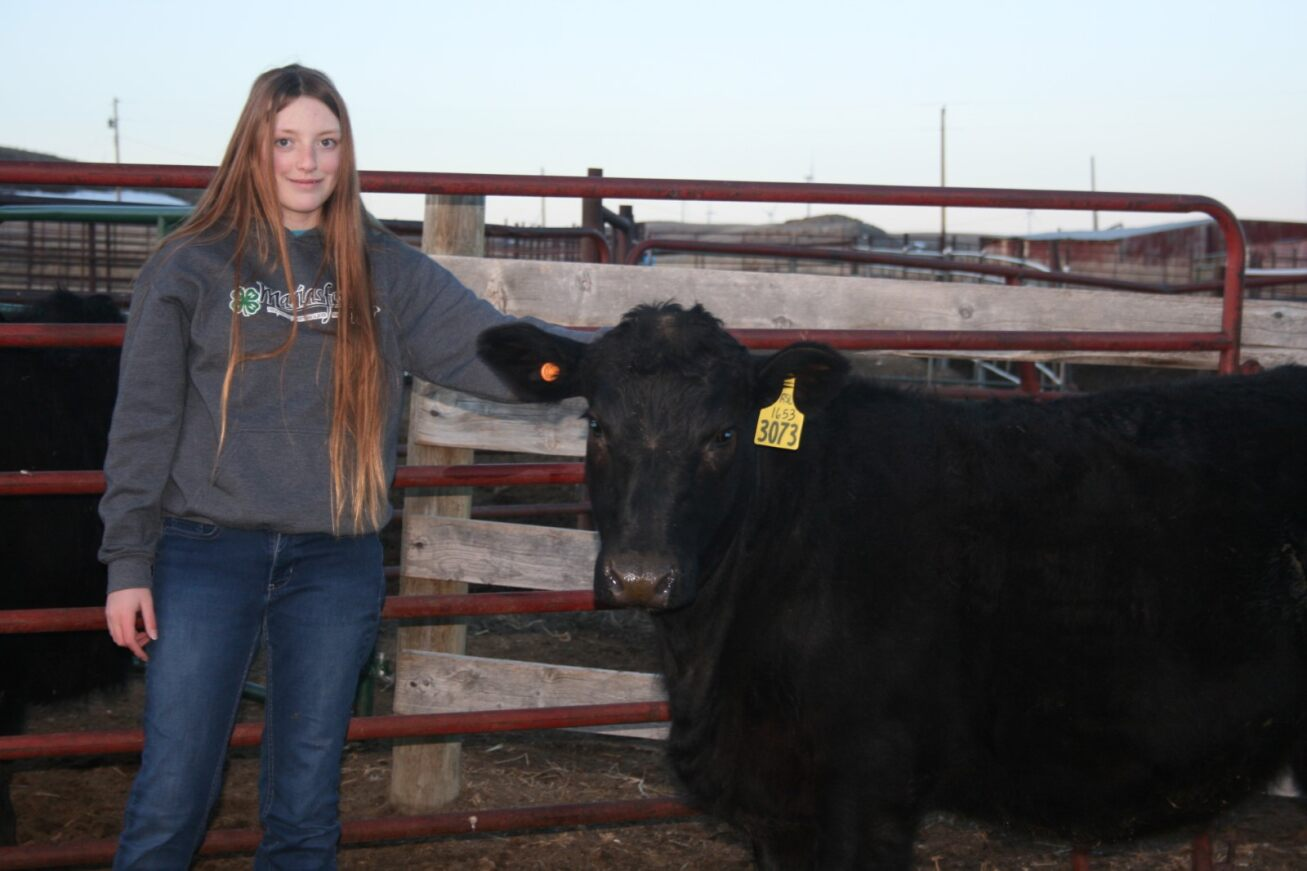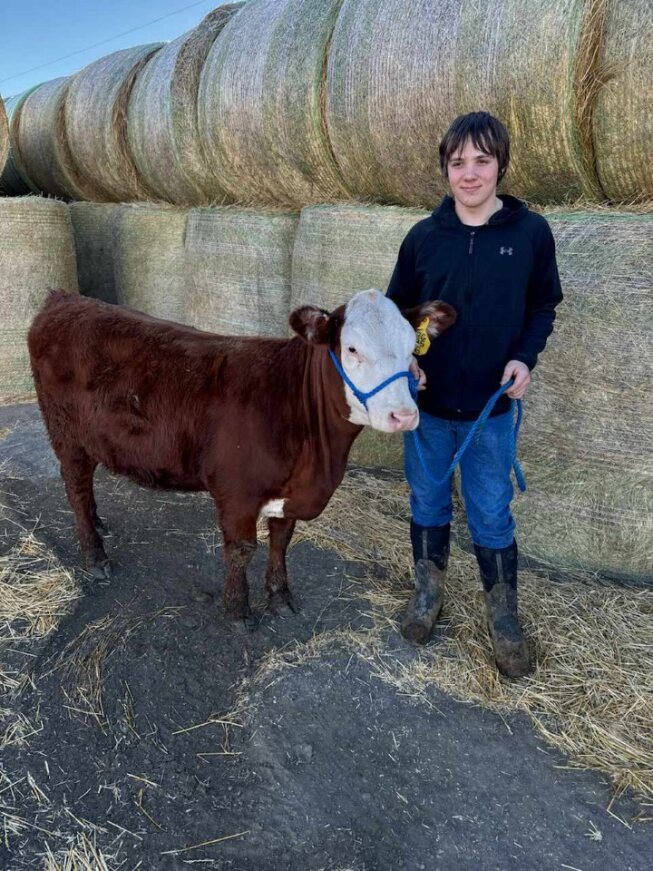Kari Lewis, MSU Extension - Glacier County
Two Glacier County 4-H beef members, Janae Roberts and Peyton Volkman, have both recently been named winners of the NILE Merit Heifer and South Devon Youth Experience programs, respectively.
The NILE Merit heifer program was developed nearly 20 years ago as a means to help youth get started in the cattle business. 4-H and FFA members ages 12 to 16 can apply and are awarded a heifer based on their merit, future goals, and ability to care for the animal. Project participants own their heifer jointly with NILE (Northern International Livestock Exposition) until the completion of the program at which point the youth takes full ownership of the heifer. For Janae Roberts, the program was an opportunity to potentially improve the genetics of her own herd, and a means to improve her public speaking skills and meet new people.
To apply, Janae submitted an application which included her goals, two pages on herself and ability to care for the heifer, three references, and three recommendation letters. “The application was kind of hard. I ran out of room to say all that I wanted, and it was challenging to say it just right,” Janae shared. In addition, she had to submit a video detailing her aspirations, facilities, etc. After submitting the application in June, it was a waiting process until mid-October when the 25 recipients were announced, including Janae! The program garners regional interest and recipients represent Montana, Idaho, Oregon, Wyoming, and Nebraska.
Janae’s heifer was donated by the 3C Cattle Company LLC of Stevensville, MT. In November,
Janae had the incredible opportunity to get her pick of the fifty plus head of Registered Angus replacement heifers from Chad and Lacey Sutherlin. “I looked at the heifers one by one and sorted off about ten I liked. I then sorted it down to three and picked my heifer who seemed to be the medium of perfect,” Janae said. She said she was looking for structural correctness, a deep body, and a wide based heifer.
Since bringing ‘Besty’ home, Janae has been busy feeding her and halter breaking her for show. In addition, she along with the other Merit Heifer participants participate in monthly Zoom calls to learn more about caring for their heifer. So far, they’ve covered nutrition and the digestive system. In addition, she submits monthly reports detailing her heifer’s feed, costs, pictures and also answers questions that will go into her overall herdsmanship award at the NILE show this October in Billings. She credits her family, Chris, Lacy, Emily, and Aiden Roberts for their help with her heifer and reporting as well.
Janae plans to have her heifer AI bred this June and will show her as much as possible including at the Marias Fair this summer. Long term, she hopes to keep her calves as replacement heifers and either sell the bull calves to other ranchers or use for 4-H steers.
“If you’re thinking of applying, apply early and talk about how well you can care for the heifer, why you are qualified, and your goals,” Janae said. While Janae is just an 8th grader, this heifer will provide a strong foundation for growing her own herd to help her reach her personal goals of ranching and possibly teaching in the future. Janae will continue to care for her heifer and in October, will show her at the NILE Merit Heifer show in Billings, MT against the other recipients. Janae joins a long list of Glacier County 4-Hers who have been NILE Merit heifer winners, including Wyatt Berkram, Coalter Littrell, JR Seewald, Mat Tuma, Christie (Tuma) Curtiss, and Karly (Tuma) Sheffield.
In November, Peyton Volkman approached Glacier County agent, Kari Lewis, to inquire about the NILE Merit heifer program as well. Applications wouldn’t open again until June 2024, but Kari had just learned of the South Devon Association NASDA Youth Experience program from Andy Van Haur. The program awards a replacement heifer calf to a deserving youth between the ages of 14 to 20 at the National Western Stock Show. “I looked into the breed, what they’d need to live a good life and I thought they’d fit well here. I was interested in the breed,” Petyon said.
Peyton completed an application detailing his skills, ability and desire to raise, care for, and learn about the breed. He shared his goals and experiences in the 4-H market beef project thus far. He also submitted two letters of recommendation as to his character and ability to care for the heifer.
“Since I found out late about the application, it was a bit rushed, but I had great recommendation letters and thought I had a decent shot,” Peyton shared of his expectations. Peyton said he'd received a call right before Christmas with the good news he had been selected the winner!
He noted, "I was really excited. I was pretty stoked to hear I won!" He also had a chance to visit with the Minnesota board member who shared the news with him.
In January, Peyton was publicly announced as the winner at the National Western Stock Show in
Denver and his heifer (donated by the C/N Ranch of Big Timber, MT) received a ride back to the north country from Andy Van Haur of Valier. She is a ‘Poundmaker’ which is half South Devon and is red with a white face. “I like a good, solid beef cow,” Peyton said. He plans to have his heifer A.I.ed this spring with hopes of raising a replacement heifer or 4-H steer for the Marias Fair and adding her to his growing herd of cows. Peyton has been active in the Market Beef project bringing a Pen of Three to the fair the past two years and receiving the Steer of Merit distinction for his steer’s carcass quality twice. However, he’s excited to learn more about the production side through the beef breeding project.
Peyton encourages other 4-Hers to apply for the program and similar opportunities. "I learned that even if you don't think you have a chance, go ahead and do it. Don't hold back. It's a great experience and even if you don't get it, it's a way to meet some really great people too."
Peyton believes the South Devon breed will be a good fit for the area and is excited to have the opportunity to grow his herd before he heads off to welding school in a couple years. Currently a sophomore at Cut Bank High School, Peyton plans to return home to run the family farm and ranch.
In addition to caring for their heifers, both Janae and Peyton are extremely active in 4-H and school. Janae, 14, participates in beef breeding, cooking, market beef, photography, teen leadership, and archery projects in 4-H in addition to FFA, FCCLA, and volleyball at Sunburst Schools. Peyton, 15, participates in football, wrestling, Babe Ruth baseball and 4-H market beef, beef breeding, and archery projects.
No doubt the NILE Merit Heifer program and South Devon Association Youth Experience program will help provide both youth a strong foundation for their futures learning about the beef industry and growing their herd. The generosity of the 3C Cattle Company and C/N Ranch to provide heifers, and caring adults willing to write recommendation letters, provide transportation, teach, serve as references or proofreaders, etc. reiterate the kindness of the 4-H and agricultural community to provide hardworking, motivated youth with a positive head start.






